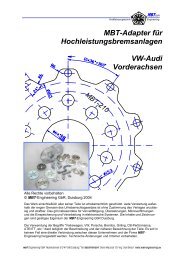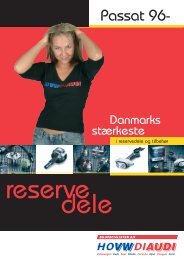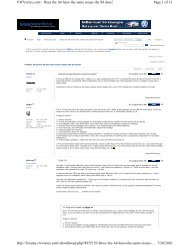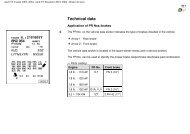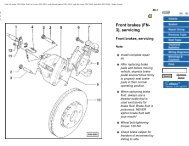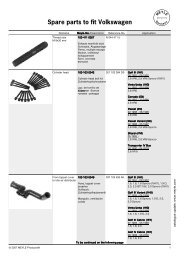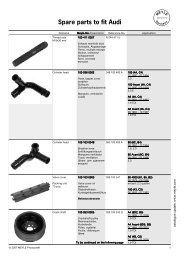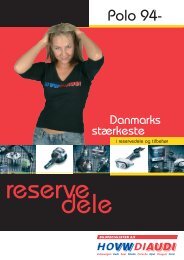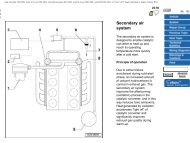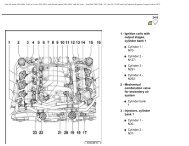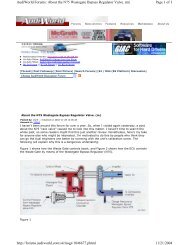VW MKII A2 MK2 Golf Jetta Fox Service Manual - VAGLinks.com
VW MKII A2 MK2 Golf Jetta Fox Service Manual - VAGLinks.com
VW MKII A2 MK2 Golf Jetta Fox Service Manual - VAGLinks.com
Create successful ePaper yourself
Turn your PDF publications into a flip-book with our unique Google optimized e-Paper software.
1 General information<br />
The 1.6 and 1.8 litre 8-valve engines are of<br />
four-cylinder, in-line, overhead camshaft<br />
design, mounted transversely at the front of<br />
the vehicle. The transmission is attached to<br />
the flywheel end of the engine.<br />
The crankshaft is of five main bearing type,<br />
its endfloat being controlled by a shouldered<br />
centre bearing or by half thrustwashers<br />
located each side of the centre bearing.<br />
The camshaft is driven by a toothed belt<br />
which is tensioned by a tensioner on an<br />
eccentric bearing. On engines manufactured<br />
before August 1985, the valves are operated<br />
by bucket type cam followers in direct contact<br />
with the camshaft. From August 1985, all<br />
engines are fitted with a redesigned cylinder<br />
head incorporating hydraulic bucket tappets<br />
in place of the previous shim bucket tappets.<br />
Camshaft bearing No. 4 is deleted on all<br />
single camshaft engines. In order to identify<br />
the type of tappets fitted, a sticker is normally<br />
affixed to the valve cover indicating that valve<br />
clearance adjustment is neither necessary nor<br />
possible.<br />
An intermediate shaft (driven by the toothed<br />
timing belt) drives the distributor and oil pump<br />
and on carburettor equipped engines, the fuel<br />
pump.<br />
The oil pump is of twin gear type, driven<br />
from the immediate shaft and incorporates a<br />
pressure relief valve.<br />
The aluminium cylinder head is of<br />
conventional design with the inlet and exhaust<br />
manifolds mounted on the rear side (as<br />
viewed with the engine in the vehicle).<br />
The crankcase ventilation system<br />
<strong>com</strong>prises a hose from the flywheel end of the<br />
valve cover to the side of the air cleaner.<br />
On fuel injection equipped engines, there is<br />
a hose to the air inlet manifold and a hose to<br />
the air cleaner from a three-way connector on<br />
the valve cover.<br />
2 Major operations possible<br />
with engine in vehicle<br />
The following operations can be carried out<br />
without having to remove the engine from the<br />
vehicle:<br />
Engine repair procedures - 1.6 and 1.8 litre 8 valve 2C•5<br />
Cylinder head bolts (engine cold) . . . . . . . . . . . . . . . . . . . . . . . . . . . . . . As for 1.05 and 1.3 litre engines<br />
Refer to illustration 5.25b. Also 40.1a and 40.1b in Part A of this Chapter.<br />
a) M8 . . . . . . . . . . . . . . . . . . . . . . . . . . . . . . . . . . . . . . . . . . . . . . . . . . 25 18<br />
a) M10 . . . . . . . . . . . . . . . . . . . . . . . . . . . . . . . . . . . . . . . . . . . . . . . . . 45 33<br />
b) . . . . . . . . . . . . . . . . . . . . . . . . . . . . . . . . . . . . . . . . . . . . . . . . . . . . . 35 26<br />
c) . . . . . . . . . . . . . . . . . . . . . . . . . . . . . . . . . . . . . . . . . . . . . . . . . . . . . 45 33<br />
d) . . . . . . . . . . . . . . . . . . . . . . . . . . . . . . . . . . . . . . . . . . . . . . . . . . . . . 50 37<br />
e) . . . . . . . . . . . . . . . . . . . . . . . . . . . . . . . . . . . . . . . . . . . . . . . . . . . . . 60 44<br />
f) . . . . . . . . . . . . . . . . . . . . . . . . . . . . . . . . . . . . . . . . . . . . . . . . . . . . . 70 52<br />
g) . . . . . . . . . . . . . . . . . . . . . . . . . . . . . . . . . . . . . . . . . . . . . . . . . . . . . 80 59<br />
* When checking the connecting rod-to-crankshaft journal radial clearance using Plastigage, tighten only to 30Nm (22 lbf ft).<br />
a) Removal and servicing of the cylinder<br />
head, camshaft and timing belt<br />
b) Renewal of the crankshaft rear oil seal<br />
(after removal of the transmission,<br />
driveplate or clutch as applicable)<br />
c) Removal of the sump and oil pump<br />
d) Removal of the piston/connecting rod<br />
assemblies (after removal of the cylinder<br />
head and sump)<br />
e) Renewal of the crankshaft front oil seal,<br />
intermediate shaft front oil seal and<br />
camshaft front oil seal<br />
f) Renewal of the engine mountings<br />
3 Major operations only<br />
possible after removal of<br />
engine from vehicle<br />
The following operations can only be<br />
carried out after removal of the engine from<br />
the vehicle:<br />
a) Renewal of crankshaft main bearings<br />
b) Removal and refitting of the crankshaft<br />
c) Removal and refitting of the intermediate<br />
shaft<br />
4 Method of engine removal<br />
1 The engine, together with the gearbox,<br />
must be lifted from the engine <strong>com</strong>partment,<br />
then the engine separated from the gearbox<br />
on the bench. Two people will be needed.<br />
2 A hoist of 150 kg capacity will be needed to<br />
lift the engine approximately 1 metre. If the<br />
hoist is not portable and the engine is lifted,<br />
then sufficient room must be left behind the<br />
vehicle to push it back out of the way so that<br />
the engine may be lowered. Blocks will be<br />
needed to support the engine after removal .<br />
3 Ideally, the vehicle should be over a pit. If<br />
this is not possible then the body must be<br />
supported on axle stands (see “Jacking and<br />
vehicle support”) so that the front wheels may<br />
be turned to undo the driveshaft nuts. The<br />
left-hand shaft is accessible from above but<br />
the right-hand shaft must be undone from<br />
underneath. Removal of the gearshift linkage<br />
can only be done from underneath, as can<br />
exhaust downpipe-to-manifold detachment.<br />
4 The exhaust downpipe-to-manifold flange<br />
connection is secured by special spring clips<br />
rather than bolts or studs and nuts. When<br />
1081 <strong>VW</strong> <strong>Golf</strong> & <strong>Jetta</strong><br />
disconnecting and reconnecting the joint, it<br />
will be necessary to use <strong>VW</strong> tool no. 3049A.<br />
Without this tool, detachment and certainly<br />
reconnection of the joint and clips is virtually<br />
impossible, so make arrangements to borrow<br />
or hire the tool in advance.<br />
5 The only other special tools required will be<br />
a set of splined key wrenches which will be<br />
needed to remove and refit the socket-head<br />
bolts used to secure certain items such as the<br />
cylinder head bolts.<br />
6 Draining of oil and coolant is best done<br />
away from the working area if possible. This<br />
saves the mess made by spilled oil in the<br />
place where you must work.<br />
7 Although not listed as an optional fitting on<br />
UK models, an air conditioning system may<br />
have been fitted. Where this is the case, the<br />
following precautions must be taken when<br />
handling refrigerant lines or system<br />
<strong>com</strong>ponents:<br />
a) Do not stress or bend flexible hose lines<br />
to a radius of less than 101 mm<br />
b) Flexible hose lines must be correctly<br />
located, must not chafe against adjacent<br />
<strong>com</strong>ponents and must be kept well clear<br />
of the exhaust manifold and downpipe<br />
c) All metal tubing lines must be kept free of<br />
kinks and must be handled with care<br />
d) Do not disconnect any of the air<br />
conditioning supply lines<br />
e) Do not weld or apply heat in the vicinity of<br />
the air conditioning lines or equipment<br />
f) If any part of the system is to be detached<br />
then it must first be depressurised by your<br />
<strong>VW</strong> dealer or a <strong>com</strong>petent air conditioning<br />
systems engineer. The only exception is<br />
the removal and fitting of the <strong>com</strong>pressor<br />
drivebelt which can be achieved in the<br />
same manner as for the alternator<br />
drivebelt<br />
5 Engine - removal<br />
Carburettor equipped<br />
4<br />
1 Disconnect the battery negative lead.<br />
2 Remove the bonnet.<br />
3 Drain the engine coolant.<br />
4 Position a suitable container beneath the<br />
engine, undo the sump drain plug and drain the<br />
engine oil - see Chapter 1. On <strong>com</strong>pletion clean<br />
the drain plug and refit it. Renew the O-ring.<br />
2C




